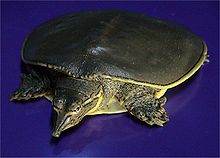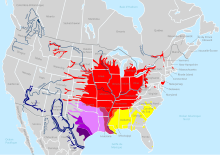Spiny softshell turtle
| Spiny softshell turtle | |
|---|---|

| |
| Scientific classification | |
| Domain: | Eukaryota |
| Kingdom: | Animalia |
| Phylum: | Chordata |
| Class: | Reptilia |
| Order: | Testudines |
| Suborder: | Cryptodira |
| Family: | Trionychidae |
| Genus: | Apalone |
| Species: | A. spinifera
|
| Binomial name | |
| Apalone spinifera | |

| |
| Synonyms[2] | |
| |
The spiny softshell turtle (Apalone spinifera) is a species of softshell turtle, one of the largest freshwater turtle species in North America. Both the common name, spiny softshell, and the specific name, spinifera (spine-bearing), refer to the spiny, cone-like projections on the leading edge of the carapace, which are not scutes (scales).
Description
The spiny softshell turtle's scientific name is very descriptive of the animal. “Apalone” comes from the Greek word “apalos” meaning soft or tender, and “spinifera” is of Latin descent; “spina-“ referring to thorn or spine and “-ifer” meaning bearing. This species is a member of the family Trionychidae, and one of the most distinguishing features of members in this family is the presence of a leathery, moderately flexible carapace.[3] This is caused by loss of keratinized scutes and some bony tissue loss. Spiny softshell turtles have webbed feet, and their feet have three claws. Another distinguishing feature of softshell turtles is the presence of a fleshy, elongated nose.
The carapace (the upper part of the shell) ranges from brown or yellow-brown to olive in color, while the plastron (lower part of the shell) is lighter, usually white or yellow. Hatchlings usually have dark spots on the carapace, but as females age, they frequently become darker in color, or their carapace becomes splotched. Males tend to maintain the same coloration pattern from birth. Coloration also varies between each subspecies, and the exact coloration can also depend on an individual turtle's environment. Spiny softshell turtles are cryptically colored, meaning that their coloration helps them blend in with their surrounding environment.
Spiny softshells also have pale lines bordered by black lines running from its head down the side of its neck. The carapace length ranges from 18-54 centimeters, with females growing larger than males. Its namesake spines are found along the anterior border of the carapace and are more commonly found in males. The variation in coloration, size, and spine presence indicates that this species exhibits sexual dimorphism.
Respiration
A. spinifera turtles are bimodal breathers, meaning that they have the ability (to some degree) to perform oxygen and carbon dioxide exchange by breathing air or while breathing underwater. A variety of factors allow for these turtles to perform respiration underwater. They have an increase of cutaneous surface area and blood flow, reduction in lung size, and increase of respiratory epithelium in the cloaca and buccopharynx. Spiny softshell turtles are more dependent on underwater respiration than other freshwater species. This has led to a low tolerance of spiny shoftshells for anoxic waters; this becomes especially important when during times of hibernation when these turtles must choose hibernacula that are unlikely to become hypoxic.
Geographic range
The spiny softshell has a wide range, extending throughout much of the United States, as well as north into the Canadian provinces of Ontario and Quebec, and south into the Mexican states of Tamaulipas, Nuevo León, Coahuila and Chihuahua.[1]
Ecological range
The spiny softshell can be found in bodies of freshwater including ponds, lakes, rivers, tributaries, and streams. They inhabit shallow water (less than 1 meter deep) but can also be found as far as 10 meters deep. They can be found in areas with varying levels of vegetation, and although they are generally found in more slowly-moving waters, this species can be found in faster moving waters than other, less-aquatic species of turtle.[4] Spiny softshells prefer waters with sandy bottoms as well as clean, sandy banks. Sandy environments are important for nesting sites, proper juvenile growth and development, and camouflage.[5] Spiny softshells migrate between warm and cold seasons. In each season, turtles generally stay in a single zone, and they move more within their zone during warm months.
Diet
Spiny softshell turtles feed on a variety of food items. They will consume insects, crayfish, fish, algal stocks and other plant material, and mussels. They are generally observed as benthic feeders; they can either actively hunt prey or bury themselves in the sand and wait to ambush prey.[6]
Taxonomy
The species was first described by Charles Alexandre Lesueur in 1827.[1] It has been redescribed numerous times, leading to some confusion in its taxonomy.[7] The recognized subspecies differ in the markings on the carapace, on the sides of the head, and on the feet. However, these markings, which are distinct as hatchlings, fade as the turtles grow larger. Adult females of the various subspecies, which grow larger than males, are not easily distinguishable from one another, and sometimes can only be assigned to a particular subspecies based on geography.[8]
Reproduction
Spiny softshells begin mating between ages 8 and 10. A large female turtle may live up to 50 years. The turtles mate in mid-to-late spring in deep water. The male will nudge the female's head while swimming, and if she chooses to mate, the male will swim above the female without clasping her with his claws (unlike other turtles). A few months later, the female turtle quickly lays her eggs along a sunny sandbar or gravel bank in a flask-shaped cavity she has dug close to the water. The turtle nests more than once during a single season. She can lay between 9 and 38 round, calcareous-shelled eggs. The eggs are laid around July and September, and they hatch in the spring. Unlike in other turtles, in the spiny softshell turtle, the sex of the hatchlings is not determined by temperature variations; it is determined by genetics.[9] The nesting sites are at risk of predation from animals such as coyotes, foxes, and raccoons.
Subspecies
Six subspecies of Apalone spinifera are recognized, including the nominate subspecies:[10]
- Northern spiny softshell turtle (or Eastern spiny softshell[11]), A. s. spinifera (Lesueur, 1827)[1]
- Gulf Coast spiny softshell turtle, A. s. aspera (Agassiz, 1857)[1]
- Black spiny softshell turtle or Cuatro Cienegas softshell turtle, A. s. atra (Webb & Legler, 1960)[1]
- Texas spiny softshell turtle, A. s. emoryi (Agassiz, 1857)[1]
- Guadalupe spiny softshell turtle, A. s. guadalupensis (Webb, 1962)[1]
- Pallid spiny softshell turtle, A. s. pallida (Webb, 1962)[1]
A previously recognized subspecies, Apalone spinifera hartwegi (Conant & Goin, 1941), has been synonymized to A. s. spinifera as of 2011.[1]
Genomics
A rough draft assembly of the A. spinifera aspera genome was completed in 2013 by The Genome Institute at Washington University - St. Louis. The assembly ASM38561v1 can be accessed via its Genbank accession ID APJP00000000.1 [1]
Gallery
-
A spiny softshell turtle.
-
A spiny softshell turtle basking in the sun.
References
- ^ a b c d e f g h i j k Rhodin 2011, p. 000.206.
- ^ Fritz & Havaš 2007, pp. 306–310.
- ^ Engstrom, T. (2004). "Multiple data sets, high homoplasy, and the phylogeny of softshell turtles (Testudines: Trionychidae)". Systematic Biology. 53 (5): 693–710. doi:10.1080/10635150490503053. PMID 15545250.
- ^ McGaugh, S. (2008). "Color variation among habitat types in the spiny softshell turtles (Trionychidae: Apalone) turtles of Cuatrocienegas, Coahuila, Mexico". Journal of Herpetology. 42 (2): 347–353. doi:10.1670/07-176.1.
- ^ Plummer, M. (2008). "Effects of habitat disturbance on survival rates of softshell turtles (Apalone spinifera) in an urban streatm". Journal of Herpetology. 42 (3): 555–563. doi:10.1670/07-217.1.
- ^ Williams, T. (1981). "The niches of two sympatric softshell turtles, Trionyx muticus and Trionyx spiniferus, in Iowa". Journal of Herpetology. 15 (3): 303–308. doi:10.2307/1563433. JSTOR 1563433.
- ^ California Turtle & Tortoise Club: Softshell Turtles.
- ^ Conant R (1975). A Field Guide to Reptiles and Amphibians of Eastern and Central North America, Second Edition. Boston: Houghton Mifflin. 429 pp. (Softshell Turtles: Family Trionychidae, pp. 76-77).
- ^ Greenbaum, Eli; Carr, John L (2001). "Sexual Differentiation in the Spiny Softshell Turtle (Apalone spinifera), a Species With Genetic Sex Determination". Journal of Experimental Biology. 290 (2): 190–200. doi:10.1002/jez.1049. PMID 11471149.
- ^ "Apalone spinifera". Integrated Taxonomic Information System. Retrieved 31 May 2012.
- ^ Species Apalone spinifera at The Reptile Database .
- Bibliography
- Rhodin, Anders G.J.; van Dijk, Peter Paul; Iverson, John B.; Shaffer, H. Bradley; Bour, Roger (31 December 2011). "Turtles of the world, 2011 update: Annotated checklist of taxonomy, synonymy, distribution and conservation status" (PDF). Chelonian Research Monographs. 5. Archived from the original (PDF) on 22 January 2012.
- Fritz, Uwe; Havaš, Peter (2007). "Checklist of Chelonians of the World" (PDF). Vertebrate Zoology. 57 (2): 149–368. Archived from the original (PDF) on 17 December 2010.
Further reading
- Behler JL, King FW (1979). The Audubon Society Field Guide to North American Reptiles and Amphibians. New York: Alfred A. Knopf. 743 pp. ISBN 0-394-50824-6. (Trionyx spiniferus, pp. 485–486 + Plates 270, 271).
- Boulenger GA (1889). Catalogue of the Chelonians, Rhynchocephalians, and Crocodiles in the British Museum (Natural History). New Edition. London: Trustees of the British Museum (Natural History). (Taylor and Francis, printers). x + 311 pp. + Plates I-III. (Trionyx spinifer, pp. 259–260).
- Lesueur CA (1827). "Note sur deux espèces de tortues, du genre Trionyx de M[onsieur]. Geoffroy-Saint-Hilaire ". Mémoires du Muséum d'Histoire Naturelle, Paris 15: 257-268 + Plates 6-7. (Trionyx spiniferus, new species, pp. 258–263 + Plate 6). (in French).
- Smith HM, Brodie ED Jr (1982). Reptiles of North America: A Guide to Field Identification. New York: Golden Press. 240 pp. ISBN 0-307-13666-3. (Trionyx spiniferus, pp. 31–33).
- Stejneger L, Barbour T (1917). A Check List of North American Amphibians and Reptiles. Cambridge Massachusetts: Harvard University Press. 125 pp. (Amyda spinifera, p. 125).
External links




